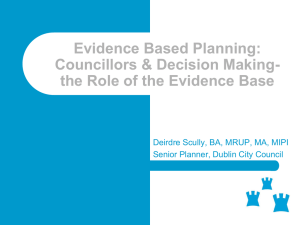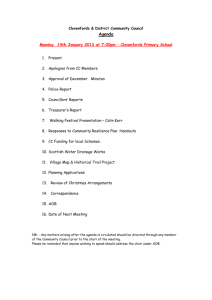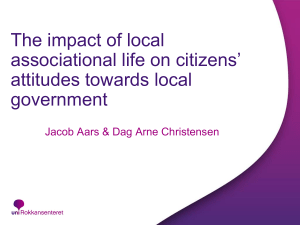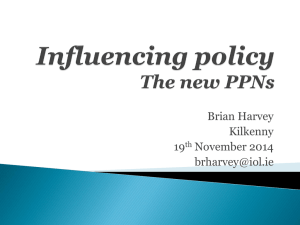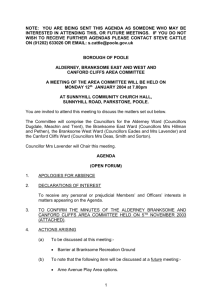Councillor census 2013 (Word
advertisement
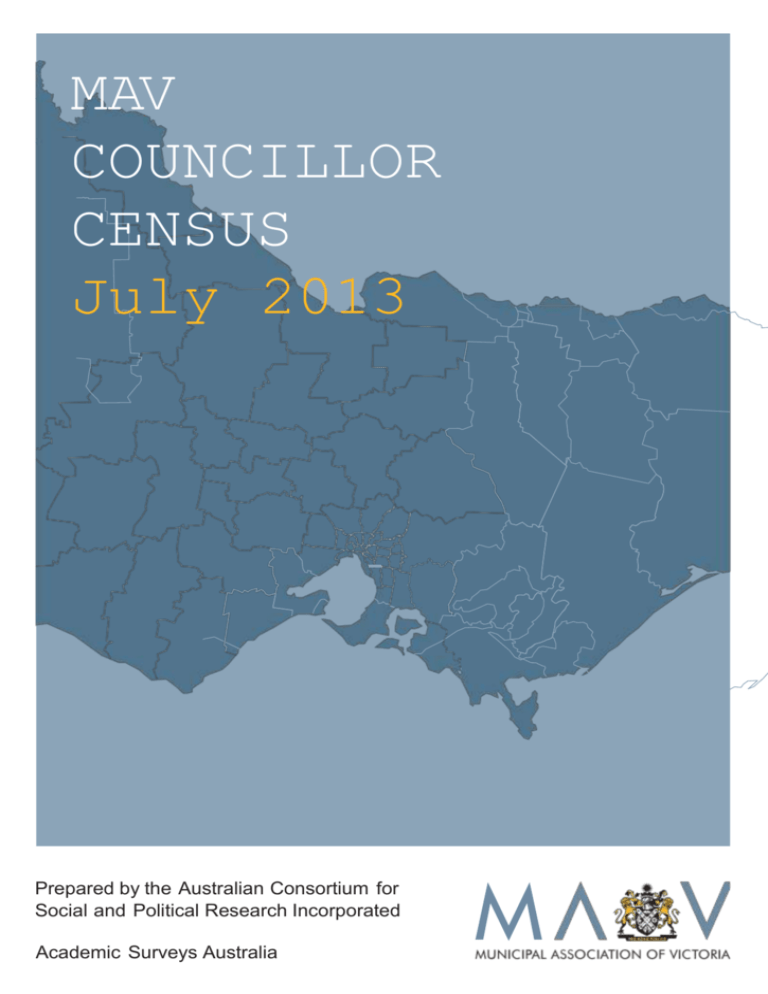
MAV COUNCILLOR CENSUS July 2013 Prepared by the Australian Consortium for Social and Political Research Incorporated Academic Surveys Australia Contents 1 2 3 4 5 6 7 8 9 10 11 12 13 14 15 16 17 18 19 20 21 Introduction Methodology Summary of main findings Council areas Gender Age Country of origin Marital status Living arrangements Caring responsibilities Employment status Employment sector Occupation Working hours Level of education Income Disability Councillor service and duties Political party membership and identification Councillor ancestry Appendix 1 3 3 3 4 5 6 7 9 10 11 12 13 14 16 17 19 20 21 23 24 25 Page 1 List of Figures 1 Gender profile, 2006, 2009 and 2013 5 2 Age distribution of councillors, 2006, 2009 and 2013 6 3 Birthplace of councillors, 2006, 2009 and 2013 7 4 Councillors’ marital status, 2006, 2009 and 2013 9 5 Percentage of councillors with caring responsibilities by gender, 2006, 2009 and 2013 11 6 Employment profile of councillors, 2006, 2009 and 2013 12 7 Employment sector, 2006, 2009 and 2013 13 8 Occupation of councillors, 2006, 2009 and 2013 14 9 Percentage of councillors working one or more hours per week for pay, 2006, 2009, 2013 16 10 Councillors’ levels of education, 2006, 2009 and 2013 17 11 Education by gender, 2006, 2009 and 2013 18 12 Income distribution, 2006, 2009 and 2013 19 13 Percentage of councillors with a disability, 2009 and 2013 20 14 Years in council service, 2006, 2009 and 2013 21 15 Hours spent in council duties by gender, 2006, 2009 and 2013 22 16 Political party allegiance, 2006, 2009 and 2013 23 List of Tables 1 Survey respondents by council area, 2006, 2009 and 2013 4 2 Type of council by gender, 2006, 2009 and 2013 (row percentages) 4 3 Age profiles across types of council areas, 2006, 2009 and 2013 (row percentages) 6 4 Birthplace of councillors, 2013 7 5 Birthplace of councillors and their parents 8 6 Councillors’ living arrangements, 2006, 2009 and 2013 (column percentages) 10 7 Occupation by gender, 2006, 2009 and 2013 (column percentages) 15 8 Length of service by gender, 2006, 2009 and 2013 (column percentages) 21 9 Councillor ancestry, 2013 24 10 Councillor ancestry specified 25 Page 2 1 Introduction The purpose of this survey was to gather data on a range of demographic characteristics to provide a profile of elected membership of local government in Victoria. This exercise was conducted in 2003 (see MAV 2003 Councillor Census, August 2003), 2006 and 2009. In 2006 there were 467 completions. In 2009, there were 430 completions (from the population of 630 councillors), which is 68 per cent of councillors. In 2013, there were 497 completions (from the population of 630 councillors), which is 79 per cent of councillors. This report incorporates data from the 2006, 2009 and 2013 surveys and highlights changes over that period, where appropriate. 2 Methodology Councillors were contacted via email inviting them to participate in the census online on 15 April 2013. Two reminder emails were sent over a period of three weeks. In week five, a paper questionnaire was sent to the councillor if they had not completed the census online. In week seven, a reminder postcard was sent to the councillors who received the paper questionnaire. In week nine, all non participating councillors were called up to three times to complete the questionnaire over the telephone, or to be reminded to complete online or via the paper questionnaire. At the end of the data collection period 334 councillors completed the census online, 79 completed the census in paper form and 84 completed the census over the telephone. 3 Summary of main findings • The majority of councillors continue to be male but the trend over the period is a slight but steady increase in female councillors and a corresponding slight but steady decrease in male councillors • The majority of councillors are above 46 years of age with 56-65 years old the most common age group. There are fewer councillors 25 and younger in 2013, as compared to 2009 but a greater number in the 26-35 age group • The majority of councillors are born in Australia but more than 30 per cent have one or more parents born overseas • 74 per cent of councillors are married in 2013 • Over 50 per cent of female councillors report they have caring responsibilities. This has risen over the period for females but fluctuated for males • Most councillors are self-employed or working • Most councillors work for a private company or are self-employed. The number employed by government has gone down • The majority of councillors are managers or professionals • Most councillors have a post school qualification and this has risen over time • In 2013 the number of female councillors with undergraduate and post graduate qualification was higher than the number of males with these qualifications • The majority of councillors earn above $52,000 per year • Over 40 per cent of councillors in 2013 are newly elected • The majority of councillors still spend between 11-30 hours per week on council duties (unchanged over the period) • About 23 per cent of councillors identify with no political party or are ‘swing’ voters (down from 29 per cent in 2009) • About 28 per cent identify as Liberal (up from 23 per cent in 2009), 21 per cent identify as Labor (ALP) (down from 26 per cent in 2009) and Other party/independent has risen to over 15 per cent (11 per cent in 2006) Page 3 4 Council areas The table below shows the number of respondents by council area. All areas have an increase in respondents in 2013. The largest increases are in inner and outer Melbourne. The second table below shows the distribution of male and female councillor respondents by council area, comparing 2006, 2009 and 2013. The table shows row percentages, which adjusts for the difference in the number of male and female respondents. Inner Melbourne (like in 2006) has females over represented (as compared to males). In large rural councils females are under represented (even more so as compared to 2006 and 2009). While in 2013 there is little change in the percentage of females as compared to male respondents in outer Melbourne and regional cities. Survey year 2006 2009 2013 Outer Melbourne (including interface) Inner Melbourne Regional Cities Large Rural Small Rural Not stated 103 72 54 120 116 2 90 74 57 97 109 3 113 97 62 104 110 11 Total 467 430 497 Table 1 Survey respondents by council area 2006, 2009 and 2013 Inner Large Melbourne Rural Outer Regional Melbourne Cities 2006 Male Female 18 27 36 32 29 30 18 11 2009 Male Female 23 23 33 26 26 33 18 18 2013 Male Female 24 29 32 21 27 33 16 17 Table 2 Type of council by gender, 2006, 2009 and 2013 (row percentages) Page 4 5 Gender Figure 1 shows that in 2013, the majority of councillors are male - 63 per cent (67 per cent in 2009) and 36 per cent (33 per cent in 2009) are female. The trend is an increase in female councillors over the three periods with a corresponding decrease in male councillors. In 2013, a third category, “Other, please specify”, for gender was added. 0.6 per cent of councillors reported their gender as “Other, please specify” in 2013. 80% Male Female Other, please specify 60% 40% 20% 0% 2006 2009 2013 YEAR Figure 1 Gender profile, 2006, 2009 and 2013 Page 5 6 Age As in 2006 and 2009 the majority of councillors in 2013 are above 46 years old. In 2013 (like in 2009) the largest age group is 56-65. In 2013 it is worth noting the increase in the 26-35 year old group, as compared to 2006 and 2009. The table below compares types of council areas by age profiles over the three periods. Rural councils have an older age profile as compared to metropolitan councils. Ages continue to become more evenly distributed in metropolitan councils, but not in regional councils. 40% 2006 2009 2013 30% 20% 10% 0% 26−35 < 25 36−45 46−55 56−65 66−75 > 75 AGE GROUP Figure 2 Age distribution of councillors, 2006, 2009 and 2013 < 25 26-35 36-45 46-55 56-65 66-75 > 75 Inner Melbourne 2006 2009 2013 4 9 3 11 12 14 21 23 27 43 22 24 19 28 27 1 5 5 0 0 0 Outer Melbourne 2006 2009 2013 2 1 2 13 6 10 23 19 18 34 34 28 14 30 28 15 8 13 0 2 1 Regional Cities 2006 2009 2013 0 2 2 11 12 5 20 20 12 33 23 33 31 36 37 4 7 12 0 0 0 Large Rural 2006 2009 2013 1 0 1 3 0 4 14 11 11 33 34 24 33 42 43 13 11 14 3 1 4 Small Rural 2006 2009 2013 0 2 0 0 1 7 6 6 6 34 24 27 40 47 41 20 19 16 0 1 2 Table 3 Age profiles across types of council areas, 2006, 2009 and 2013 (row percentages) Page 6 7 Country of origin In 2013, 87 per cent of councillors are Australian born (with 13 per cent born overseas). This is approximately the same as 2009, when 85 per cent were Australian born. When looking at councillors and their parents’ birthplaces in 2013, 304 councillors reported both parents and themselves as being born in Australia, while 161 reported that either they or one of their parents were born overseas. 100% Australia Overseas 80% 60% 40% 20% 0% 2006 2009 2013 YEAR Figure 3 Birthplace of councillors, 2006, 2009 and 2013 Country of birth Frequency Australia Overseas Not stated 419 62 16 Total 497 Table 4 Birthplace of councillors, 2013 Page 7 In 2013, 1.5 per cent of councillors identified as Aboriginal or Torres Strait Islander. This compares with 0.4 per cent in 2006 and 0.9 per cent in 2009. All Australian Councillor born in Australia, both parents born overseas One parent born in Australia and councillor born in Australia One parent born in Australia and councillor born overseas All born overseas Not all birthplaces specified Survey year 2006 2009 311 296 37 33 46 34 1 2 60 58 12 7 2013 304 44 59 1 57 32 Total 467 497 430 Table 5 Birthplace of councillors and their parents Page 8 8 Marital status In 2013, 74 per cent of councillors were married compared with 71 per cent in 2009. 80% 2006 2009 2013 60% 40% 20% Other Never married Widowed Divorced Separated De facto Married 0% Figure 4 Councillors’ marital status, 2006, 2009 and 2013 Page 9 9 Living arrangements There was little change in councillors’ households over the period with the majority living with a partner or a partner and children. Survey year 2006 2009 A partner 40 42 A partner plus one or more children 36 35 No one, you live by yourself 10 10 One or more children 5 5 One or both of your parents 1 2 One of both of your parents plus others 1 1 One or more adults who are neither your partner nor your parent 1 2 A partner plus other adults 1 0 A partner plus one or more children plus other adults 1 1 Not stated 3 3 2013 40 37 8 4 2 1 1 1 1 4 Table 6 Councillors’ living arrangements, 2006, 2009 and 2013 (column percentages) Page 10 10 Caring responsibilities In 2009, 31 per cent of males reported caring responsibilities, compared with 35 per cent in 2013. By contrast, females reporting caring responsibilities increased from 47 per cent in 2009 to 51 per cent in 2013. The trend over the period is that the percentage of females with caring responsibilities is rising while the percentage of males with caring responsibilities has fluctuated over the period. 60% Male Female 50% 40% 30% 20% 10% 0% 2006 2009 2013 YEAR Figure 5 Percentage of councillors with caring responsibilities by gender, 2006, 2009 and 2013 Page 11 11 Employment status Employment profiles have remained fairly stable although 2013 shows a decrease in those working and an increase in those with household duties, helping family, a disability and studying. 50% 2006 2009 2013 40% 30% 20% 10% Studying Disabled Helping family Unemployed Household duties Retired Working Self−employed 0% Figure 6 Employment profile of councillors, 2006, 2009 and 2013 Page 12 12 Employment sector Over the three periods (2006, 2009 and 2013), councillors were most likely to be employed by a private company. A change seen in 2013 is the next largest sector, self-employed without employees. The number of councillors employed by both state and local government has decreased and the number employed by charities has increased (and is closer to the 2006 figure). 35% 2006 2009 2013 30% 25% 20% 15% 10% 5% Local Govt Govt owned business Federal Govt NGO/charity Self−employed w/o employees Self−employed w employees Family business/farm State Govt Private 0% Figure 7 Employment sector, 2006, 2009 and 2013 Page 13 13 Occupation The largest occupational groups represented were managers and administrators, and then professionals. These two groups accounted for 74 per cent of the 2009 and 73 per cent of the 2013 sample. It should be noted that some of the change in occupation (in particular the differences between professionals and associate professionals) could be due to a change in how the occupation data was collected. In 2006 and 2009 we asked councillors to match their job to a list of occupational categories (they ‘self-selected’ their occupation). In 2013 we asked respondents to write in their job title and main tasks (as text responses) and then these were independently coded to the occupational classification. 50% 2006 2009 2013 40% 30% 20% 10% Labourers Elementary clerical Intermediate production and transport Intermediate clerical Advanced clerical Tradespersons Associate professionals Professionals Managers/administrators 0% Figure 8 Occupation of councillors, 2006, 2009 and 2013 Page 14 Managers and administrators Professionals Associate professionals Tradespersons and associated workers Advanced clerical and service workers Intermediate clerical, sales and service workers Intermediate production and transport workers Elementary clerical, sales and service workers Labourers and related workers Not codeable Blank Male 2006 2009 2013 Female 2006 2009 2013 44 37 4 6 3 2 1 1 2 0 0 42 25 10 5 2 4 0 2 1 4 5 40 36 7 1 9 4 0 1 1 0 0 28 34 9 2 3 7 0 1 2 4 10 43 31 6 12 2 1 1 1 3 0 0 31 44 6 3 8 5 0 2 2 0 0 Table 7 Occupation by gender, 2006, 2009 and 2013 (column percentages) Page 15 14 Working hours Councillors were asked how many hours per week they worked for pay. Among the 77 per cent of councillors in 2013 recording one or more hours a week (78 per cent in 2006 and 81 per cent in 2009) the average number of hours worked per week increased to 40.9 hours (up from 38.1 hours in both 2006 and 2009). 2013 77% 2009 81% 2006 78% Figure 9 Percentage of councillors working one or more hours per week for pay, 2006, 2009, 2013 Page 16 15 Level of education Figure 10 shows the percentage of councillors that have completed various levels of education, while figure 11 shows this by gender. The general trend, shown in figure 10, is higher levels of TAFE and higher education completion. 2013 shows a slight decrease in undergraduate but this is offset by the increase in those with a postgraduate degree. 35% 2006 2009 2013 30% 25% 20% 15% 10% 5% Completed postgraduate degree Completed undergraduate Completed TAFE Completed year 12 Highschool not completed 0% Figure 10 Councillors’ levels of education, 2006, 2009 and 2013 Page 17 Figure 11 shows the overall trend of higher levels of education. In particular, in 2013 there are higher numbers of female councillors with undergraduate and postgraduate degrees and male councillors with TAFE qualifications. 40% 2006 Female 2006 Male 2009 Female 2009 Male 2013 Female 2013 Male 30% 20% 10% Completed postgraduate degree Completed undergraduate Completed TAFE Completed year 12 Highschool not completed 0% Figure 11 Education by gender, 2006, 2009 and 2013 Page 18 16 Income $2,000 or more per week ($104,000 or more per year) 2013 2009 2006 $1,500−$1,999 per week ($78,000−$103,999 per year) $1,000−$1,499 per week ($52,000−$77,999 per year) $800−$999 per week ($41,600−$51,999 per year) $700−$799 per week ($36,400−$41,599 per year) $600−$699 per week ($31,200−$36,399 per year) $500−$599 per week ($26,000−$31,199 per year) $400−$499 per week ($20,800−$25,999 per yeat) $300−$399 per week ($15,600−$20,799 per year) $200−$299 per week ($10,400−$15,599 per year) $160−$199 per week ($8,320−10,399 per year) $120−$159 per week ($6,240−$8,319 per year) $1−$119 per week ($1−$6,239 per year) Nil income 0% 5% 10% 15% 20% 25% 30% Figure 12 Income distribution, 2006, 2009 and 2013 Page 19 17 Disability In 2009, five per cent of councillors indicated they had a disability. In 2013, six per cent of councillors indicated they had a disability. 2009 5% 2013 6% Figure 13 Percentage of councillors with a disability, 2009 and 2013 Page 20 18 Councillor service and duties Figure 14 shows that 44 per cent of councillors were newly elected in 2013. As compared to 2006 and 2009 fewer have served two to three years. Those that have served four to six years has gone up slightly over the period. 50% 2006 2009 2013 40% 30% 20% 10% 0% 1 or less (newly elected) 2−3 4−6 7−9 10−15 16−25 26+ YEARS IN COUNCIL SERVICE Figure 14 Years in council service, 2006, 2009 and 2013 1 year or less (newly elected) 2-3 years 4-6 years 7-9 years 10-15 years 16-25 years 26+years 2006 Male 30 12 20 12 12 11 2 Female 45 16 22 7 5 4 1 2009 Male 38 5 21 11 14 9 2 Female 49 4 25 14 6 2 1 2013 Male 40 2 24 9 13 9 3 Female 48 5 21 12 10 2 1 Table 8 Length of service by gender, 2006, 2009 and 2013 (column percentages) Page 21 The number of newly elected councillors has gone up slightly for males and remained relatively stable for females. Longer serving councillors (over 10 years) are more likely to be male. Figure 15 shows that the majority of councillors spend 11-30 hours in their council duties (this is largely unchanged), with the second largest group spending 31-50 hours. 70% 2006 Female 2006 Male 2009 Female 2009 Male 2013 Female 2013 Male 60% 50% 40% 30% 20% 10% 0% 10 or less 11−30 31−50 51 or more HOURS IN COUNCIL DUTIES Figure 15 Hours spent in council duties by gender, 2006, 2009 and 2013 Page 22 19 Political party membership and identification Figure 16 shows that in 2013 there was some change in political party membership with an increase in affiliation with Liberal, a drop in Labor (ALP) and an increase in other party/independents. About 23 per cent report no party or that they are a ‘swing’ voter. 30% 2006 2009 2013 25% 20% 15% 10% 5% Other party/independent No party/swing National Liberal Labor (ALP) Green Australian Democrat 0% Figure 16 Political party allegiance, 2006, 2009 and 2013 Page 23 20 Councillor ancestry The table below shows councillor ancestry. The question used to gather this information was: What is your ancestry (provide up to two ancestries only): English, Irish, Scottish, Italian, German, Chinese, Australian, Other, please specify (open text). The table below lists the combinations of those selected (or ticked) with ‘other’. This table shows the diversity of ancestry among councillors. The largest numbers are English, Scottish, Irish and Australian combinations. The details of the ‘other’ combinations of ancestries are contained in Appendix 1. Ancestry Frequency English English and Irish Other Australian English and Australian English and Scottish Irish and Scottish Irish Scottish English and German Italian English and Other Irish and Other Irish and Australian Scottish and Other Australian and Other Chinese Scottish and Australian Irish and Italian Scottish and German Chinese and Other German Italian and Australian German and Other English and Irish and Scottish German and Australian Irish and Scottish and Other Italian and German Italian and Other Scottish and Italian Not stated 79 53 48 42 39 38 27 23 23 18 17 14 9 7 6 5 5 5 4 4 3 3 3 2 1 1 1 1 1 1 14 Total 497 Table 9 Councillor ancestry, 2013 Page 24 21 Appendix 1 As in 2006 and 2009 the majority of councillors in 2013 are above 46 years old. In 2013 (like in 2009) the largest age group is 56-65. In 2013 it is worth noting the increase in the 26-35 year old group, as compared to 2006 and 2009. The table below compares types of council areas by age profiles over the three periods. Rural councils have an older age profile as compared to metropolitan councils. Ages continue to become more evenly distributed in metropolitan councils, but not in regional councils. Ancestry Frequency Greek Dutch French Welsh Maltese Polish Russian Danish Macedonian Austrian Cambodian Chilean Lebanese Sri Lankan Turkish American Bulgarian Croatian Egyptian Hungarian Indian Jewish Lithuanian Maori Native American New Zealander Norwegian Portuguese Prussian Slovakian Slovenian South African Swiss Ukrainian Vietnamese West Indies Not stated 14 9 9 6 4 4 4 3 3 2 2 2 2 2 2 1 1 1 1 1 1 1 1 1 1 1 1 1 1 1 1 1 1 1 1 1 Total 89 Table 10 Councillor ancestry specified Page 25 MAV 12/60 Collins Street Melbourne Victoria 3000 Phone 61 3 9667 5555 Email inquiries@mav.asn.au Web www.mav.asn.au The MAV Councillor Census 2013 has been prepared by the Municipal Association of Victoria (MAV). Academic Surveys Australia, the survey arm of the Australian Consortium for Social and Political Research Incorporated (ACSPRI), was engaged by the MAV to prepare and conduct the survey. It follows on from the earlier censusus conducted by the MAV in 2009 and 2006. The efforts of Academic Surveys Australia, ACSPRI are most appreciated. © Copyright Municipal Association of Victoria, 2013. The Municipal Association of Victoria is the owner of the copyright in the publication MAV Councillor Census 2013. No part of this publication may be reproduced, stored or transmitted in any form or by any means without the prior permission in writing from the Municipal Association of Victoria. All requests to reproduce, store or transmit material contained in the publication should be addressed to the MAV Councillor Development Officer on 9667 5555 or inquiries@mav.asn.au. The MAV can provide this publication in an alternative format upon request. Page 26
